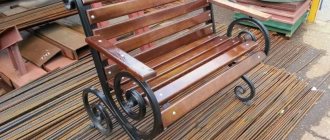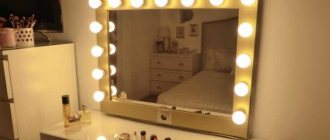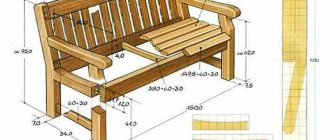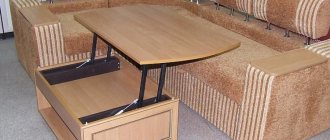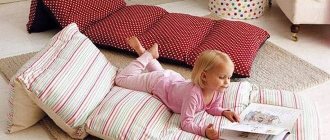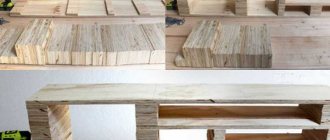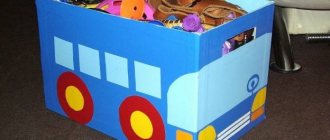Choosing fabric for a tablecloth
The tablecloth on the dining table should be pleasant, pleasing to the eye and setting you up to enjoy dining. In addition to the aesthetic side, do not forget that the dining table is the place where there will definitely be crumbs, drops of tea and stains from sauces, so the material from which the table covering is made should be quickly wiped off or washed and easily ironed.
A beautiful tablecloth - comfort in the house
When choosing fabric for a tablecloth, you should consider the following parameters:
- Purpose (dining, guest or holiday).
- Form.
- Room interior.
Interior in one style
- Quality of the material.
- Material cost.
For a dining table that will be used daily, linen and cotton in non-marking shades are suitable; these fabrics are traditional and elegant. Silk, satin, textured or smooth look perfect on the festive table; these fabrics are very elegant. It is very convenient to use modern fabrics for sewing:
- Mati, its composition includes 60% cotton and 40% polyester, which makes it wear-resistant and durable. In addition, mati is treated with an oil-repellent substance and greasy stains are removed from it easily and quickly.
Important! This fabric has a fire hazard class 1, it ignites quickly.
- The crane consists of cotton fibers with polyesters. It is treated with agents that repel grease and dirt.
Beauty from a crane
These fabrics are suitable for sewing tablecloths for restaurants and for the home.
Note! When choosing fabric for a tablecloth, you should not buy a smooth and slippery fabric; it will slide off the table and wrinkle under your hands.
There is also a huge selection of Teflon-impregnated textiles - soft, durable, easy to wash, these fabrics have a wide range of colors and textures.
Required materials and tools
To sew a product with your own hands, you will need a minimum set of materials and tools:
- First of all, this is, of course, fabric, thread and needle.
- Sewing machine for smooth and neat seams.
- Scissors (ideally for fabric).
- Tape measure.
- Ruler.
- Tailor's pins to avoid basting the fabric by hand.
- Pattern if the product will have a round or oval shape.
- Chalk or soap for applying patterns to fabric.
You might be interested in Ready-made patterns for large dresses for sizes 50, 52 - 60
Only basic tools required
Here, perhaps, is the entire list of necessary tools for sewing a tablecloth at home.
Sewing the base of the tablecloth
First of all, I finished the edges of all three layers. For this I needed an overlocker, but you can use the zigzag stitch mode on a machine. Next, I folded all three layers together and secured them along the perimeter with pins. After that, I laid the seams along the marked lines.
It must be remembered that the fabrics must be gathered with the right side out (we are talking about the two outer layers). Since all sides are zigzag, and this does not look very attractive in the final version (finished product), the edges need to be folded twice.
The easiest way to do this is to first iron the edges with an iron. The first time, leave about five centimeters along the edges, then fold the material and iron it another centimeter. After this, machine stitch the fixed edges. Remember that they must be sewn from the bottom layer (the so-called underside of the tablecloth).
Comedian Ksenia Korneva shared a photo with her younger brother
Hidden shelves, bathroom and more: everyday life of a large family living on a bus
Ten Easter eggs in mass-produced cars that the manufacturer hid
How to measure a table depending on its shape
According to the rules of etiquette, the tablecloth should hang from the table to a certain length, which varies depending on the purpose of the covering:
- For the dining table - 20 cm.
- For a holiday - 30 cm.
- For official receptions and wedding banquets - 40 cm.
- For a buffet table - up to the floor.
To determine how much fabric you will need to sew a tablecloth, you need to measure the tabletop, add the length of the overhang and the hem allowance for the fabric (2.5-4 cm).
Important! To make the edge of the tablecloth heavier, you can leave a 10 cm allowance, 5 cm per hem, or trim the edge with a wide braid.
For a square table, calculating the size of the canvas is very simple. To do this, you only need to measure the length of one side of the table, add the length of the overhang and the allowance.
Square table top
For a rectangular table, you will need to measure two adjacent sides and add additional values. For example: the length of the table is 1.5 m and the width is 80 cm. For a tablecloth on the dining table you will need fabric measuring 1 m 98 cm in length and 1 m 28 cm in width.
To calculate the size of a product for a round table, you need to measure the diameter of the table, add the length of the overhang and allowances.
Note! The greatest difficulty will be in determining the size for an oval table.
In order to accurately repeat the oval of the table, you will have to make a pattern for the tablecloth. To do this, display the exact shape of the tabletop on paper, attach it to the panel and add the length of the overhang and allowance.
Oval table top
Step-by-step pattern of an oval tablecloth
The pattern should clearly follow the oval of the tabletop; to do this, trace its outline. This is done either using tracing paper or directly on the material.
First option:
- The paper is placed on the table and, pressed down with something heavy at the four corners, a line is drawn along the edge of the tabletop.
- The tracing paper pattern is aligned and cut in the center.
- For cutting, the canvas is folded in half. Pin the paper pattern with pins, aligning the folds.
- Along the edge on all sides, add 30-40 cm for overhang and 1-2 cm for allowances.
- Circle with chalk. Cut along the contour.
Reference! The falling part of the tablecloth usually covers no more than 3/4 of the table height.
Second option:
- Spread the canvas on the table, aligning the centers, so that it hangs over the edges.
- Then the required distance is measured from the floor and marks are made with chalk. This distance depends on the desired length of the tablecloth hanging.
- After the marks are made, the fabric is laid out on a plane, for example, on a clean floor, and the marks are connected.
- Fold the material in half, matching the lines, pin and cut out.
Important! Before cutting, the fabric is subjected to wet heat treatment so that it shrinks and there are no creases left on it.
Step-by-step sewing of a tablecloth for a round table
The cover on a round table looks very beautiful, covering the tabletop and hanging in loose waves, it will add romance and elegance to the room in which such a table is located.
Step 1. Calculation of fabric consumption
To calculate the fabric consumption for a round table, you need to measure the diameter of the tabletop and divide the resulting value by 2 to find out the radius. Add the length of the overhang and the length of the allowance to the radius and multiply the sum by 2. For example: (table diameter 2 m/2 + 30 cm overhang + 4 cm allowance) * 2 = size of the required fabric 2 m 68 cm by 2 m 68 cm.
You might be interested in Clothing patterns for newborns: what you can sew yourself
Step 2: Cut the fabric
The purchased piece of fabric needs to be cut. To do this, fold the canvas four times horizontally and vertically with the front side inward. To prevent the canvas from spreading, pin it together with pins and measure the following value: radius + overhang + allowance. You need to measure using a measuring tape and chalk. Apply one end of the centimeter to the inner corner, and the other to one of the sides of the resulting square at the required distance and move to the other side, making marks with chalk. Connect the marked marks to form an arc. Carefully cut off the excess along the line and process it with an overlocker so that the edges do not fray.
Cutting fabric
Step 3. Corner treatment
A round tablecloth, of course, has no corners, but if the tablecloth is square or rectangular, then the process of processing the corners must be approached very responsibly so that they turn out perfectly smooth and beautiful.
To process and hem corners you will need an iron and a ruler. First you need to mark the planned distance for the hem, this is done twice. Along the line, first fold and iron the first hem, then the second. You should smooth it carefully so that a clear trace of the line remains. By turning the corner you can see a square. You need to tuck the corner so that this square folds in half diagonally, and cut off the resulting small triangle. Next, you need to fold the first hem back and turn the corner inward, fold the second hem and press it. For reliability, you can secure it with a pin.
Corner processing
Step 4. Sew the hem
How to hem a round tablecloth. You need to measure and mark hem lines along the entire edge, fold and baste or secure with pins. For convenience, the hem can be ironed. Carefully stitch with minimal indentation or hem with an invisible seam by hand.
Step 5. Decoration
An ordinary tablecloth is sewn easily and simply, but if you want to add a touch of comfort, originality and extravagance, the tablecloth can be further decorated.
Do this using the following techniques:
- Playing with color or texture. The product can be made from two types of fabric, and they can be combined as a flight of fancy or the general interior of the room suggests.
- Frill. You can play with the length and volume of the overhang; if you add frills or drapery, you will get an elegant, lush tablecloth.
You may be interested in this Instructions for starching fabric at home
Playful tablecloth with ruffles
- Lace. You can use fine lace for edging on fancy tablecloths or thick lace for a country style linen tablecloth, there are many options. Since you can sew lace to a tablecloth in different ways, choose the most suitable one. The lace must either be sewn or crocheted onto the tablecloth with an overlap or below the overhang.
To decorate a tablecloth, you can use satin, beads, finishing ribbons, embroidery and other decorations; even a simple stitch made in a contrasting color can decorate the product.
We sew a tablecloth in 1 evening
There are several ways to sew tablecloths, because the corners and side cuts of the fabric can be processed in different ways. In this material, I described a basic method, having mastered which you can sew with your own hands not only festive or everyday tablecloths, but also kitchen napkins, towels and runners with neat corners and edges.
Step one
Measure the length and width of the tabletop; Determine the desired length of the fabric overhang, that is, the distance from the edge of the tabletop to the edge of the future tablecloth. The fabric overhang can be 20-40 cm or be floor-length. The longer the overhang, the more elegant the tablecloth will be, but also the more inconvenient to use, so for an everyday option, an overhang length of 20-30 cm is suitable; When determining the length of the overhang, take into account the percentage of fabric shrinkage after washing - for cotton fabric and burlap you need to add 10 cm to the desired overhang length, for linen - 10-15 cm. You can go the other way - pre-wash and then iron the fabric thoroughly. Now take paper and pen and calculate the fabric consumption using the following simple formula:
FABRIC LENGTH = TABLE LENGTH + (OVERWAY LENGTH x 2) + (5 cm x 2) - hem
FABRIC LENGTH=TABLE WIDTH +(OVERWAY LENGTHx2)+(5cmx2)-hem
Step two
Cutting the fabric Iron the fabric if necessary, then lay it out on the work surface, make marks with a ruler and pencil, and then cut off the excess; patterns are not needed for a simple rectangular or square tablecloth.
Step three
Processing the corners Now we need to decorate the corners so that they look beautiful even from the inside out. To do this: Place the fabric face down on the table, fold its edges 1 cm to the wrong side, secure the folds with pins (baste if necessary) and iron along the entire perimeter of the fabric.
Next, on both sides of the corner, measure out segments 2 times larger than the width of the hem you planned (in this master class, the width of the hem is planned to be 4 cm, so a distance of 8 cm is measured from the corner). Then both marks must be connected using a ruler and pencil.
Fold the fabric in the corner (wrong side out) lengthwise so that the marks match and secure the fold with pins. Then we stitch the corner along the markings.
We cut off the excess in the corner, leaving only 5 mm seam allowance. Also trim the edge of the remaining seam allowance at the fold diagonally as shown in the photo below. This must be done so that the corner of the tablecloth turns out evenly.
We turn the corner out, correct it and iron it. Next, we process the remaining 3 corners of the tablecloth using the described method. This is what you should get.
And finally, we begin to process the sides: iron the hems of the entire tablecloth, secure with pins and sew (from the inside out) by machine or by hand with a blind seam at a distance of 1 mm from the fold.
Making your own napkins
When napkins sewn in the same style lie on the tablecloth, it looks beautiful and rich. You can also make napkins with your own hands from leftover fabric, or by planning the consumption in advance. Moreover, doing this is not difficult, like sewing a tablecloth.
First you need to decide what shape the napkins will be: square, rectangular or round, then outline the size, add seam allowances to it and cut it out. Then repeat the same steps as when sewing a tablecloth: iron the hem, work the corners, stitch the edges. The decor of the napkins can match the decor of the tablecloth, you can reduce it proportionally or come up with a different design.
Two-color product
Original options
Tablecloths made from two plain fabrics of the same color, but in different tones, look contrasting and unusual.
Path to pleasure
The coating, made in the form of a path, looks original.
Openwork sophistication
Openwork tablecloths, crocheted or sewn from pieces of lace, on a bare table or on a fabric base, are delicate and elegant for a romantic dinner or a pompous lunch.
DIY beauty
Sewing a tablecloth with your own hands is very easy. And you can get a lot of pleasure from the process, starting from the choice of fabrics and colors, the choice of which is very large and you can choose a fabric that will suit the interior of the room. The size of the tablecloth made by yourself will be exactly under the dining table and you will not have to tuck it or extend it with another tablecloth. And most importantly, with your own hands you can make a work of art, the likes of which no one else will have.
